 The Two Micron All Sky Survey at IPAC
The Two Micron All Sky Survey at IPAC
|
|
|
 Atlas Images of Uranus, Neptune, and their moons. Uranus and Neptune
were observed serendipitously by the 2MASS Southern Facility, during routine
operations on 1998 June 7 and June 11 UT, respectively. Both planets appear
very blue, i.e., they are not nearly as bright in the Ks band as in
the shorter wavelength bands, due to more reflection of sunlight at short
wavelengths and to absorption of light by methane gas in their atmospheres.
The moons, or satellites, of both planets have icy surfaces with no (or very
little) atmospheres. They
simply reflect sunlight by various amounts, depending on the albedo, or
reflectivity, of each moon's surface. Umbriel has a surprisingly dark, icy
surface. Miranda is the innermost and smallest of the five large Uranian moons.
Triton is odd, in that it is in a highly-inclined retrograde orbit around
Neptune, leading planetary scientists to infer that Triton was captured by
Neptune's gravity. For more information about these and other planets, see
NASA/JPL's Welcome to the Planets
and NASA/GSFC's
Planetary Fact Sheets.
Moon identification in and further analysis of these 2MASS images by
B. Nelson (IPAC). (Field size each 5.3´ × 5.3´.
Image size 176 kB.)
Atlas Images of Uranus, Neptune, and their moons. Uranus and Neptune
were observed serendipitously by the 2MASS Southern Facility, during routine
operations on 1998 June 7 and June 11 UT, respectively. Both planets appear
very blue, i.e., they are not nearly as bright in the Ks band as in
the shorter wavelength bands, due to more reflection of sunlight at short
wavelengths and to absorption of light by methane gas in their atmospheres.
The moons, or satellites, of both planets have icy surfaces with no (or very
little) atmospheres. They
simply reflect sunlight by various amounts, depending on the albedo, or
reflectivity, of each moon's surface. Umbriel has a surprisingly dark, icy
surface. Miranda is the innermost and smallest of the five large Uranian moons.
Triton is odd, in that it is in a highly-inclined retrograde orbit around
Neptune, leading planetary scientists to infer that Triton was captured by
Neptune's gravity. For more information about these and other planets, see
NASA/JPL's Welcome to the Planets
and NASA/GSFC's
Planetary Fact Sheets.
Moon identification in and further analysis of these 2MASS images by
B. Nelson (IPAC). (Field size each 5.3´ × 5.3´.
Image size 176 kB.)
 Atlas Image of the planet Pluto.
In IAU Circular No. 7518, Sykes et al. (2000) report the detection and
photometry of Pluto obtained by the 2MASS Southern Facility on 1999 April
10.33 UT, at J = 12.78, H = 12.62, and Ks = 12.92.
(Field size 5´ × 5´. Image size 119 kB.)
Atlas Image of the planet Pluto.
In IAU Circular No. 7518, Sykes et al. (2000) report the detection and
photometry of Pluto obtained by the 2MASS Southern Facility on 1999 April
10.33 UT, at J = 12.78, H = 12.62, and Ks = 12.92.
(Field size 5´ × 5´. Image size 119 kB.)
See identification of Jupiter's moons by B. Nelson (IPAC)
here.
For each 2MASS Survey and Calibration scan, the time of observation of the field is used to predict which of the numbered asteroids and comets with good orbits would have been in the field during the observation. If an asteroid or comet is predicted to have been observed, a search for a positional match between the asteroid and a 2MASS detection is conducted.
In this way, highly uniform near-infrared photometry for hundreds, if not thousands, of asteroid and comet apparitions can be obtained. In addition, highly accurate positional measurements can be made for all detected asteroids, which can then be used to update and improve orbital elements.
Here are a few of examples of asteroids we have located so far:
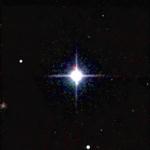 Atlas Image mosaic of the largest asteroid in
the Solar System, 1 Ceres, seen against the Virgo
Cluster of galaxies on 2000 Apr 6 UT during routine operations of the
northern 2MASS facility on Mt. Hopkins, AZ. The asteroid is seen about
13.7´ west and 25.6´ south of the large spiral galaxy
M100. Ceres is quite bright in this
image, with Ks=5.50, J-H=0.37, and H-Ks=0.09 mag.
Purplish known persistence artifacts trail (in decreasing
brightness) due north of the asteroid. The fainter reddish "star" immediately
east of due north, and the fainter whitish "star" immediately west of due
south of the asteroid are known 2MASS "filter glint" artifacts. Sykes et al.
(2000, Icarus, 146, 161) have studied asteroids detected by 2MASS, and the
colors for Ceres are consistent with those for other C-type (carbonaceous
chondritic) asteroids.
The 2MASS Second Incremental Data Release Point Source Catalog contains 3804
associations with known asteroids.
(Field size 20´ × 31´. Image size 1.7 Mb!)
Atlas Image mosaic of the largest asteroid in
the Solar System, 1 Ceres, seen against the Virgo
Cluster of galaxies on 2000 Apr 6 UT during routine operations of the
northern 2MASS facility on Mt. Hopkins, AZ. The asteroid is seen about
13.7´ west and 25.6´ south of the large spiral galaxy
M100. Ceres is quite bright in this
image, with Ks=5.50, J-H=0.37, and H-Ks=0.09 mag.
Purplish known persistence artifacts trail (in decreasing
brightness) due north of the asteroid. The fainter reddish "star" immediately
east of due north, and the fainter whitish "star" immediately west of due
south of the asteroid are known 2MASS "filter glint" artifacts. Sykes et al.
(2000, Icarus, 146, 161) have studied asteroids detected by 2MASS, and the
colors for Ceres are consistent with those for other C-type (carbonaceous
chondritic) asteroids.
The 2MASS Second Incremental Data Release Point Source Catalog contains 3804
associations with known asteroids.
(Field size 20´ × 31´. Image size 1.7 Mb!)
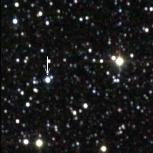 Atlas Image showing the Solar System asteroid 2 Pallas, one of the most
studied and the second brightest of these minor planets. These data are part
of the Spring 1999 data release, which will contain a number of other
detections of known asteroids. Identification of the objects takes place as
part of the 2MASS pipeline processing.
Near-infrared photometry of asteroids can tell much
about the Sun-reflecting surface composition, for example, the amount and
nature of any organic solids or ices coating the asteroid's rocky interior.
The properties of this regolith affect the albedo, or reflectivity, of the
asteroid. Using thermal emission models for asteroids, for instance, a number
of parameters, including diameter and thermal history, can be derived. The
observed colors and inferred compositions of asteroids can place constraints
on the thermal environment in the early Solar System, providing clues to the
formation of the major planets, including the Earth.
(Field size 4.4´ × 6.2´. Image size 118 kB.)
Atlas Image showing the Solar System asteroid 2 Pallas, one of the most
studied and the second brightest of these minor planets. These data are part
of the Spring 1999 data release, which will contain a number of other
detections of known asteroids. Identification of the objects takes place as
part of the 2MASS pipeline processing.
Near-infrared photometry of asteroids can tell much
about the Sun-reflecting surface composition, for example, the amount and
nature of any organic solids or ices coating the asteroid's rocky interior.
The properties of this regolith affect the albedo, or reflectivity, of the
asteroid. Using thermal emission models for asteroids, for instance, a number
of parameters, including diameter and thermal history, can be derived. The
observed colors and inferred compositions of asteroids can place constraints
on the thermal environment in the early Solar System, providing clues to the
formation of the major planets, including the Earth.
(Field size 4.4´ × 6.2´. Image size 118 kB.)
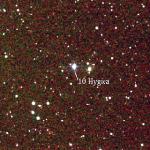
The solar system asteroid 10 Hygiea.
(Field size 8´ × 8´. Image size 281 kB.)
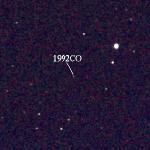
The solar system asteroid 1992CO.
(Field size 6.5´ × 6.5´. Image size 136 kb.)
This asteroid just happened to move across our calibration images on 1998
April 4. Click here
to watch a movie of its motion!
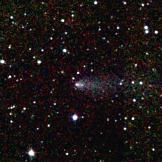 Atlas Image mosaic of comet 52P/Harrington-Abell,
which was serendipitously observed by 2MASS on 1998 Oct 8 UT
and is among twenty comets included in the
2MASS Second Incremental Data Release. Comets, of course, are within our
Solar System and orbit the Sun, and therefore do not move sidereally (that is,
as the stars do). Astronomers, however, have determined the
ephemerides, or orbital parameters, for large numbers of known comets, so
their positions in the sky along their orbits can be accurately predicted.
Occasionally, comets, asteroids, and even planets can "accidentally" wander
into the Survey. Comets reflect sunlight, yet near-infrared photometry can
provide useful compositional and structural information about these objects.
This comet was seen optically to experience a significant outburst in 1998
July (IAUC 6975) and became unusually bright by August (IAUC 6994), exceeding
visual magnitude 11 by 1999 February (IAUC 7113). Its coma diameter was
1-2´ and tail length of about 2´ in 1998 (IAUC 6975). In 2001
December the comet was seen to have split into two (IAUC 7769), following
a brightening by more than two magnitudes between 2001 August and September
(IAUC 7773).
(Field size 6.7´ × 6.7´. Image size 207 kb.)
Atlas Image mosaic of comet 52P/Harrington-Abell,
which was serendipitously observed by 2MASS on 1998 Oct 8 UT
and is among twenty comets included in the
2MASS Second Incremental Data Release. Comets, of course, are within our
Solar System and orbit the Sun, and therefore do not move sidereally (that is,
as the stars do). Astronomers, however, have determined the
ephemerides, or orbital parameters, for large numbers of known comets, so
their positions in the sky along their orbits can be accurately predicted.
Occasionally, comets, asteroids, and even planets can "accidentally" wander
into the Survey. Comets reflect sunlight, yet near-infrared photometry can
provide useful compositional and structural information about these objects.
This comet was seen optically to experience a significant outburst in 1998
July (IAUC 6975) and became unusually bright by August (IAUC 6994), exceeding
visual magnitude 11 by 1999 February (IAUC 7113). Its coma diameter was
1-2´ and tail length of about 2´ in 1998 (IAUC 6975). In 2001
December the comet was seen to have split into two (IAUC 7769), following
a brightening by more than two magnitudes between 2001 August and September
(IAUC 7773).
(Field size 6.7´ × 6.7´. Image size 207 kb.)
 Atlas Images, each
covering 4.8´ × 4.8´ on the sky, of the comets C/1998 K1
(Mueller) and C/1998 M2 (LINEAR).
Occasionally, 2MASS serendipitously encountered
solar system bodies during its routine operations (see the discussion of the
known asteroid, comet, planet, and satellite associations in the Second
Incremental Data Release). As reported in IAU Circular No. 7500,
M. Sykes, R. Cutri, J. Fowler, D. Tholen, & M. Skrutskie found "prediscovery"
apparitions of these two comets, before their optical discoveries, in
2MASS Atlas Images acquired at the Northern Facility on Mount Hopkins
and Southern Facility on Cerro Tololo, respectively. Comet C/1998 K1 was
seen on 1998 April 4.316 UT at Ks=14.7, J-H=0.3, and
H-Ks=0.2, and on May 10.223 at Ks=14.9, J-H=0.5, and
H-Ks=0.0. Comet C/1998 M2 was seen on May 4.404 at
Ks=14.3, J-H=0.5, and H-Ks=0.0.
Both comets showed some coma, but with no obvious tail.
(Field size each 4.8´ × 4.8´. Image size 263 kb.)
Atlas Images, each
covering 4.8´ × 4.8´ on the sky, of the comets C/1998 K1
(Mueller) and C/1998 M2 (LINEAR).
Occasionally, 2MASS serendipitously encountered
solar system bodies during its routine operations (see the discussion of the
known asteroid, comet, planet, and satellite associations in the Second
Incremental Data Release). As reported in IAU Circular No. 7500,
M. Sykes, R. Cutri, J. Fowler, D. Tholen, & M. Skrutskie found "prediscovery"
apparitions of these two comets, before their optical discoveries, in
2MASS Atlas Images acquired at the Northern Facility on Mount Hopkins
and Southern Facility on Cerro Tololo, respectively. Comet C/1998 K1 was
seen on 1998 April 4.316 UT at Ks=14.7, J-H=0.3, and
H-Ks=0.2, and on May 10.223 at Ks=14.9, J-H=0.5, and
H-Ks=0.0. Comet C/1998 M2 was seen on May 4.404 at
Ks=14.3, J-H=0.5, and H-Ks=0.0.
Both comets showed some coma, but with no obvious tail.
(Field size each 4.8´ × 4.8´. Image size 263 kb.)
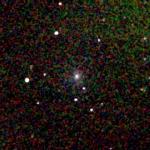 Atlas Image of the comet
C/1997 J2 (Meunier-Dupouy). A large number of comets have been
serendipitously imaged during the routine course of 2MASS. A list of comets
in the Second Incremental Data Release can be found
here. This comet, "une comète Française,"
discovered in 1997 May independently by Meunier and Dupouy (also by Jean
Mueller, Palomar Observatory), has a relatively large perihelion distance
(3.76 AU), and visually reached two maxima, both at about 10.5 visual
magnitudes, in 1997 November and, again, in 1998 August, the second when it
was at its smallest distance from Earth (2.49 AU). The 2MASS images were made
on 1998 October 22, as the comet became more distant and fainter (about 12
visual magnitudes). The apparent coma diameter at that time was about one
arcminute. Its spectrum, or component colors, most closely resembles the
light it is reflecting, that is, the light of our Sun.
(Field size 4.5´ × 4.5´. Image size 122 kb.)
Atlas Image of the comet
C/1997 J2 (Meunier-Dupouy). A large number of comets have been
serendipitously imaged during the routine course of 2MASS. A list of comets
in the Second Incremental Data Release can be found
here. This comet, "une comète Française,"
discovered in 1997 May independently by Meunier and Dupouy (also by Jean
Mueller, Palomar Observatory), has a relatively large perihelion distance
(3.76 AU), and visually reached two maxima, both at about 10.5 visual
magnitudes, in 1997 November and, again, in 1998 August, the second when it
was at its smallest distance from Earth (2.49 AU). The 2MASS images were made
on 1998 October 22, as the comet became more distant and fainter (about 12
visual magnitudes). The apparent coma diameter at that time was about one
arcminute. Its spectrum, or component colors, most closely resembles the
light it is reflecting, that is, the light of our Sun.
(Field size 4.5´ × 4.5´. Image size 122 kb.)
Return to 2MASS Image Gallery Homepage